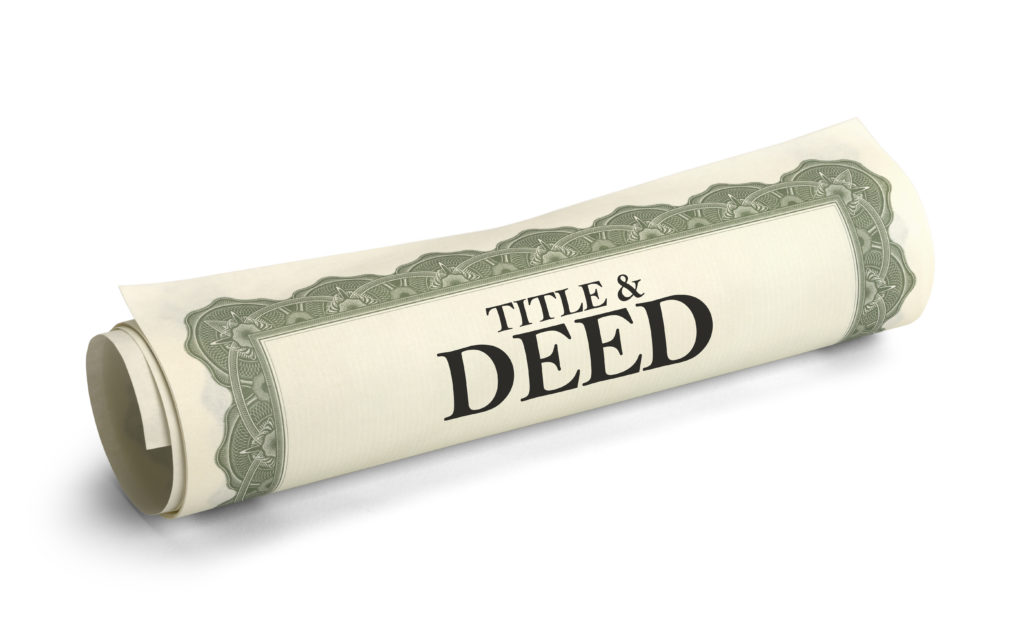Buying and selling property is a complex experience. The exchange of such a valuable asset is riddled with paperwork. No exchange of property is complete without having to handle a deed. However, did you know there are different types of deeds? In this article, we are going to cover everything from a quitclaim deed to a deed of trust, and everything in between. Get your signing pen ready, because you are about to become a well-informed property owner!
What is a Deed of Trust?
More than likely, the purchase of a home or property is going to involve borrowing money. If that is the case, you will likely need a deed of trust. A deed of trust is a written arrangement between a borrower and a lender. This document appoints an unbias third party, known as a trustee, as the bearer of the legal title of the property. This arrangement serves as leverage while the borrower pays off the loan to the lender. In the meantime, the borrow maintains the right to the equitable property title. Therefore, the borrower is responsible to care for and maintain the property.
Deed Definition
To better understand a deed of trust, let’s take it back a few steps. What is a deed, in general? A deed is a legal instrument used to transfer ownership rights in property sales. A deed is a physical document that is signed by both the buyer and the seller in a property transaction.
The property on a deed may be a home, condo, commercial space, or a plot of land. Every piece of real estate property should have a deed.
Trust Definition
Like deeds, there are various types of trusts. However, for the sake of this article, we only need to know what the definition of a general trust is. A trust is a financial agreement in which a third party (trustee) bears ownership of a certain asset on behalf of a beneficiary.
Parties Involved in a Deed of Trust
To further clarify, a deed of trust is an agreement between three different parties. Everyone involved plays a specific role.
- The Trustor – Whoever is borrowing money to purchase the property. Bearer of the equitable title
- The Trustee– A neutral third party that holds the legal title (sometimes called the “bare” title)
- The Lender – Also known as the “beneficiary”. The lender is providing the money for the loan
This relationship is intended to protect the lender in the event the trustor defaults on their payments.
The Role of the Trustee
The function of the trustee in a deed of trust requires extrapolation. You may assume that a trustee is required to take over the trustors payments in case of default. However, that is not the case. Instead, a trustee will handle the sale of the property if the trustor can no longer cover their debt. The property itself is collateral in a deed of trust.
As previously mentioned, the trustee must be an impartial, unbias third party. This fact is a crucial element of a deed of trust. The impartiality of the trustee helps prevent fraud. The trustee should not financially favor the lender or the trustor in terms of the sale. Once the property is sold, the trustee will distribute the funds acquired from the sale. The lender will receive the amount outstanding from the loan. The trustor, on the other hand, will receive whatever is leftover.
Title vs. Deed
At this point, you may be thinking to yourself “deeds and titles sound like the same thing”. However, that is not legally the case. A title states that you legally own the right to access and use a property as you so desire. A deed, on the other hand, is a legal document that is used in the transfer of property ownership. However, in order to have full and true ownership of a property, your name must be on both the property’s title and the deed.
What is a Title?
A property title expresses ownership over a property. Having your name on a title gives you the right to access, alter, and sell a piece of property. A title also makes you responsible for the properties maintenance and well being.
Legal Title vs. Equitable Title
While a title indicates ownership, it can be split amongst parties. In a deed of trust, the trustee holds the legal title of the property. The legal title represents actual ownership. If the property only has a legal title documented, the title owner will be responsible for the care and maintenance of the property. Additionally, the legal title holder would have the right to alter and enjoy the property as they please. Finally, a legal title allows you the right to sell the property.
On the other hand, the trustor maintains an equitable title in a deed of trust. In this case, the trustor would have the sole rights to maintain, alter, and enjoy the property. Therefore, if a property has both a legal title and an equitable title, only the equitable title holder can benefit from the property.
For example, let’s say Sarah signed a deed of trust and has the equitable title to her home. Her trustee, Jason of Small Town Title and Loan, is the legal title holder. Sarah has the sole right to use and enjoy the house to her liking. Jason cannot simply show up with friends wanting to host a dinner party. As the legal title holder, Jason merely has the right to sell the house is Sarah defaults on her loan. Once Sarah has successfully paid her loan in full, she will become the legal title holder.
Elements of a Deed of Trust
A deed of trust form will outline the following information:
- The amount of money being borrowed (also referred to as the “principle”)
- Names and roles of all involved parties
- A legal description of the property (more specific than just the address and the paint color)
- Any known floor plans, diagrams, or blueprints related to the property
- Dates of both the signing and maturity of the loan
- Various additional riders, requirements, and provisions
- How to legally proceed should the trustor default on payments
- Acceleration or alienation clause (more on that to follow)
The requirements listed above can vary based on the state and the type of property detailed in the deed. Be sure to check the necessary requirements for your specific transaction.
Legal Description
To enumerate, a legal description is far more than just a simple street address. “Legal description” is a term often used in real estate regarding property sales. Previous deeds on the property should have a legal description listed. You can usually find previous property deeds at your local county clerk’s office or recorder of deeds office. Many of the offices even offer online access!
While a physical address should be included on a deed, a legal description is more specific. Different types of properties may require different descriptors. However, the description will usually detail survey information. Such as lot or block references, subdivisions names, and detailed plot measurements.
Acceleration and Alienation Clauses
These provisions mandate that the buyer pay the remaining balance in full under specific circumstances. Namely, if the buyer chooses to sell the property. In that case, the acceleration clause will kick in and require the buyer to pay their outstanding loan balance on the property. These type of clauses are standard in every loan agreement these days. According to the U.S. Securities and Exchange Commission, verbiage included in the clause is as follows:
- “In the event the Property or any part thereof or any interest therein is sold, conveyed or alienated by the Trustor, whether voluntarily or involuntarily, except as prohibited by law, all obligation secured by this instrument, irrespective of the maturity dates express therein, at the option of the holder hereof and without demand or notice, shall immediately become due and payable.”
Not only will the trustor (buyer) owe the remaining balance on the loan, but may be subject to fees and interest charges.
Mortgage vs. Deed of Trust
More often than not, when someone buys a house they will have to borrow money to do so. Borrowing money is referred to as a “loan”. Once the money has been granted, the lender is going to want to protect their investment. The lender will either do this in the form of a mortgage or a deed of trust.
Banks and other large lending companies tend to favor using mortgages. Conversely, smaller companies or individual lenders will likely choose to use a deed of trust. Both documents have the same purpose: to ensure the loan is paid back to the lender. Additionally, both mortgages and deeds of trust do this by placing a lien on the property. A lien uses the property as collateral. Meaning, the lender has the right to sell the property if the loan defaults.
The Differences: Mortgage vs. Deed of Trust
While mortgages and deeds of trust are similar in many ways, they are also different. For example, a mortgage is a contract between two parties: the lender and the borrower. Conversely, a deed of trust includes an additional third party: the trustee. As previously stated, the trustee holds the legal title while the loan is being repaid.
Furthermore, the quintessential difference lies in what happens when the trustor (borrower) cannot pay back the loan. In terms of a mortgage, the home will go through a judicial foreclosure process. Translation: the property sale must go through the courts and is instigated by the lender filing a lawsuit. Unfortunately, lawsuits are notoriously expensive and time-consuming. In the case of a mortgage loan default, this process negatively affects both the lender and the borrower.
On the other hand, a loan default with a deed of trust goes through a non-judicial foreclosure. Should the loan payments falter, the foreclosure of the home can bypass the courts. Naturally, this makes the process less of a time-consuming financial burden.
Who can Use a Deed of Trust?
As previously mentioned, rules and regulations pertaining to deeds of trust vary by state. In fact, not all states even allow deeds of trust. Conversely, some states require a deed of trust when money is borrowed for real estate purposes. Fortunately, Rocket Lawyer has a cohesive list of states that allow deeds of trust.
If your state has the option to use a deed of trust, your lender will likely encourage it over a mortgage. Deeds of trust are a better deal for the lender. Should the borrow default, the lender can avoid the expensive judicial foreclosure process.
Deed of Reconveyance
You did it! You paid off your loan! What now? The lender will issue a deed of reconveyance. This document formally states that the borrower has paid off their debts in full. Better yet, a deed of reconveyance transfers the legal title of the property to the trustor (buyer).
Additionally, a Deed of Reconveyance goes by different names in some states. Such as Full Reconveyance, Release of Deed of Trust, or Reconveyance of Deed of Trust.
Finally, a Deed of Reconveyance must be notarized filed with your local recorder of deeds or county recorder. A buyer will typically have 30 days to file without penalty. Once the document is accepted by the state, the property will officially be paid for and free of liens.
Promissory Note
A promissory note is often used in tandem with a deed of trust. Therefore, it is important to discuss how a promissory note fits into this process. A promissory note is a document in which the borrower promises to pay back a loan. This document, sometimes simply called a “note”, will go on to specify the terms of the loan. A note will typically include the following information:
- Borrower and Lender information – Legal names, addresses, contact information, and sometimes a social security number for added identification purposes
- Loan Amount and Terms – The full amount of the loan, and the agreed-upon increments of payment. This section will typically include any applicable interest rates and payment schedules. Additionally, the inciting date as well as when the loan must be paid off
- Security Agreement – This is where the mortgage or deed of trust comes in. A security agreement details the collateral promised, should the loan default. In the case of a deed of trust, the collateral is the property purchased.
Promissory notes are used in all types of transactions and agreements. Home and car loans, business loans, student loans, and even personal loans amongst friends and family. The note is a legally binding record of a transaction. Promissory notes help ensure a lender will get their money back.
What is a Notary?
A number of the documents mentioned in this article require notarization. If you are unfamiliar, notarization is when an unbias third party, called a notary, witnesses the signing of important documents. A proper notarization involves several steps:
- Identification – The foundation of notarization is proper identification of the signing party
- Confirmation – Confirming identity is simply the tip of the iceberg. A notary will also ensure that each signing party understands the document in full. Finally, the notary will confirm that everyone involved is signing by choice and not by force
- Oath or Affirmation – Sometimes, certain documents require a jurat notarization, or “jurat”. The foundational element of a jurat is the addition of a spoken oath by the signer. This oath confirms that, to the knowledge of the signer, the contents of the document are true. A signer can also opt to agree to an affirmation. The context is the same as an oath, however, an affirmation does not make the promise to God or a higher power.
- Signing – Not all states require that the actual signing take place in the presence of a notary. However, it is best to air on the side of caution and wait to sign until a notary is physically present
- Notary Stamp – Finally, the notary themselves will sign and stamp the document. The stamp will include the name of the notary, their state of commission, and the date their certification expires (note: Your document will remain valid after their stamp expires)
Notary laws are not federally mandated. Therefore, laws and requirements vary depending on the state where the notarization is taking place. Be sure to check your local notary laws to ensure a valid notarization.
Where can I find a Notary?
Notaries are far more common than you may think. In fact, there are millions of certified notaries in the United States alone. The hours, pricing, and availability of notaries vary locally. However, here are a few places you can typically find notary services:
- Your place of business! – Save yourself the hassle of running around town, many companies have a notary on staff for business use. However, they will typically allow employees to use their services for personal use as well
- Financial Institutions – Banks and local credit unions almost always offer notary services. Better yet, if you are a client their services are often complimentary
- Colleges and Universities – Many educational institutions offer free or low-cost notary services to students and faculty
- Car dealerships, Insurance offices, and real estate agencies – Due to high notarization demand internally, certain businesses will have a notary on staff that is also available for public use
- Mobile Notaries – Better yet, have a notary come to you! This option is prominent in large cities. Naturally, this premium service can have a high price tag. However, you will save valuable time
Keep in mind that notaries are official representatives of the state. Therefore, they serve the public. For this reason, you cannot get turned away for notary services if you are not a customer of any of the above places.
What do I Need to get my Deed Notarized?
Especially in matters pertaining to buying a selling property, the paperwork can be a tornado of confusion. To make your life easier, be sure to literally cross all the t’s and dot the i’s when attending a notary appointment. You should bring with you:
- The document requiring notarization (duh) – Make sure to bring the original copy. Should any amendments be added, a new notarization will be necessary. Save time at the appointment by filling out any necessary fields. However, resist the urge to sign it until in the presence of a notary
- Photo Identification – A valid, photo i.d. is mandatory for an official notarization to take place. A current drivers license or passport are the two most commonly accepted forms of i.d. If you have a different type of i.d. be sure to check whether or not it is an acceptable form of identification
- All signing parties – Many documents require signatures from multiple people in order to be accepted. Save time and money by having all necessary parties present at once for notarization. If this is not possible (say, if someone lives in another state) a document can be notarized multiple times, even by multiple notaries. However, this significantly lengthens the process and typically costs more money to process
- Notary payment – As previously mentioned, some businesses offer free notary services. However, most notaries will charge a per-signature fee. This fee is usually legally capped at a certain amount by state. California notaries, for example, cannot charge more than $10 per signature. However, ertain services may incur additional fees. For example, a mobile notary usually charges a fee for travel time
Check with your local preferred notary to make sure you have all the necessary requirements for your state and/or type of document.
Deed of Trust: In Conclusion
Buying property is a thrilling step in a persons journey. Whether you are buying your first family home or your seventh business office – you are procuring a space for memories to form and life to unfold. However, property transactions are riddled with layers of paperwork and legal snafus. Chief amongst them: a deed of trust. This document aids in the purchase of a property in which a loan is required. A trustee will hold the legal title to the property, while the buyer pays back the loan. During this time, the buyer maintains the equitable title to the asset, and therefore the right to enjoy the property. Specifics of real estate transactions vary by state, so be sure to research the details of your location. Hopefully, this article cleared up some of the process of property transactions. Happy property buying and selling!
Sources
https://www.rocketlawyer.com/article/what-is-a-deed-of-trust-ps.rl
https://smartasset.com/mortgage/house-deed
https://www.rocketlawyer.com/article/mortgage-vs-deed-of-trust.rl
https://smallbusiness.chron.com/components-promissory-75239.html
https://www.thebalance.com/definition-of-deed-of-trust-1798782
https://www.fidelity.com/life-events/estate-planning/trusts
https://www.lawdepot.com/contracts/deed-of-reconveyance-form/?loc=US#.XMIdcZNKjow
https://www.investopedia.com/terms/d/deed-of-reconveyance.asp
https://www.realtor.com/advice/buy/deed-vs-title/
https://www.rocketlawyer.com/article/whats-the-difference-between-a-property-deed-and-a-title-ps.rl
https://www.legalzoom.com/articles/what-is-a-promissory-note
https://www.nationalnotary.org/knowledge-center/about-notaries
https://www.thebalanceeveryday.com/where-to-notarize-affidavit-896914




